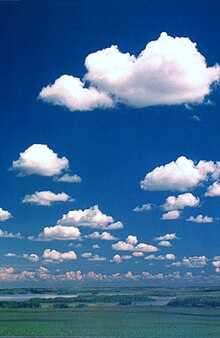
Back Volksweerkunde Afrikaans বতৰৰ লোককথা Assamese Һауа торошо тураһында халыҡ һынамыштары Bashkir Bauanregl BAR Meteorologia popular Catalan Pranostika Czech Vejrvarsel Danish Bauernregel German Veterproverbo Esperanto فرهنگ مردم هواشناسی Persian
This article needs additional citations for verification. (January 2009) |

Weather lore is the body of informal folklore related to the prediction of the weather and its greater meaning.
Much like regular folklore, weather lore is passed down through speech and writing from normal people without the use of external measuring instruments. The origin of weather lore can be dated back to primeval men and their usage of star studying in navigation.[1] However, more recently during the Late Middle Ages, the works of two Greek philosopher-poets, Theophrastus of Eresus on Lesbos and Aratus of Macedonia, are known for shaping the prediction of weather. Theophrastus and Aratus collated their works in two main collections for weather lore: On Weather Signs and On Winds. These were used for helping farmers with harvest, merchants for trade and determining the weather the next day.[2]
Astrology and weather lore have been closely interlinked for many years - with each planet often being associated with a weather state. For example, Mars is red and must therefore be hot and dry. Prevalent in ancient Roman thought, astrologists used weather lore to teach commoners of the star and cloud formations and how they can be used to see the future.[2] From this, three main schools of weather lore thoughts developed during the Late Middle Ages as Astrology became more popular throughout Europe.[3] One which related to winds and clouds and had some scientific basis. A second type connected with saints' days possessed doubtful validity but was quite popular nonetheless during the Middle Ages. A third type treated the behaviour of birds and animals, which has been found to be controlled more by past and present weather rather than to be a true indication of the future.[1]
Before the invention of temperature measuring devices, such as the mercury thermometer, it was difficult to gather predictive, numerical data. Therefore, communities used their surroundings to predict and explain the weather in upcoming days.[4]
Today, the majority of weather lore can be found in proverbs. However, much of the weather lore fantasy is still prevalent in today's seasonal calendar, with mentions such as the annual saints' days, the passage of the months, and weather predictions made from animal behaviour. The creation of the astrological signs in Babylonian mythology can also be attributed to the study of stars and its association with weather lore.[2]

- ^ a b Hazen, H. A. (July 1900). "The Origin and Value of Weather Lore". The Journal of American Folklore. 13 (50): 191–198. doi:10.2307/533883. JSTOR 533883.
- ^ a b c Encyclopedia of climate and weather. Schneider, Stephen Henry., Root, Terry Louise., Mastrandrea, Michael D. (2nd ed.). New York: Oxford University Press. 2011. ISBN 978-0-19-531386-4. OCLC 714802771.
{{cite book}}: CS1 maint: others (link) - ^ F.R.S, D. Brunt SC D. (1946-06-01). "Meteorology and Weather Lore". Folklore. 57 (2): 66–74. doi:10.1080/0015587X.1946.9717813. ISSN 0015-587X.
- ^ Bergen, Fanny D.; Newell, W. W. (1889). "Weather-Lore". The Journal of American Folklore. 2 (6): 203–208. doi:10.2307/534149. ISSN 0021-8715. JSTOR 534149.